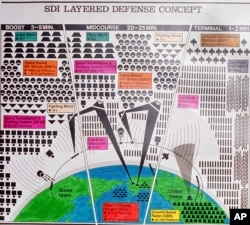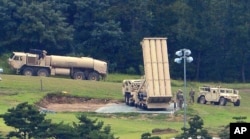Scientists and NASA officials who spearheaded development of a space-based missile defense system in the 1980s are urging its revival to counter emerging nuclear threats from North Korea and other rogue states.
False alarms over a North Korean missile attack on Hawaii this month indicate how Pyongyang’s nuclear capability has taken center stage as America’s main security concern since the North Korean government’s recent testing of ICBMs capable of reaching the United States.
The controversial U.S. Space Defense Initiative (SDI), started under President Ronald Reagan, was often ridiculed as “Star Wars” by critics in the U.S. Congress and media who balked at its high cost.
Many also questioned its effectiveness against the Soviet Union’s massive and sophisticated nuclear arsenal.
Back on the drawing board?
The program never got past the drawing board and was largely abandoned at the end of the Cold War.
“Everybody lost interest in SDI when the Soviet Union collapsed, but vast technological advances over the past 30 years and the emerging nuclear threat from North Korea revive its need and feasibility,” says Robert Scheder, a systems analyst with the RAND Corp. who designed the original model for space-based defense.
He conducted early simulations with a weapon system consisting of orbiting rockets equipped with sensor technology designed to intercept attacking missiles at the “boost phase,” or immediately after launch, before they can release decoys and countermeasures.
But there were significant technological shortcomings.
The fleet of satellite interceptor systems, also known as Brilliant Pebbles or Smart Rocks, could not entirely neutralize a Russian first strike involving thousands of nuclear warheads, according to Scheder.
They could, however, provide fail-safe protection against the threat now posed by North Korea, which can only launch a maximum of three or four missiles at a time, he told VOA in an interview from his home in Spain.
Critics: It’s still lacking
Thomas Roberts, a critic of space-based defense at the Center for Strategic and International Studies in Washington, says that even a small salvo of missiles could penetrate the space shield.
“The enemy can first launch a decoy to make a gap through the interceptor shield and then launch a salvo through that gap, which the Pentagon cannot close fast enough,” Roberts said.
At least 1,600 killer satellites would be needed to fully cover the Earth, costing defense dollars that could be just as effectively spent in deploying more conventional interceptor missiles and launching more satellites to track, surveil and identify incoming enemy missiles.
The calculated $100 billion cost for placing thousands of Brilliant Pebbles in orbit would have absorbed the entire U.S. defense budget in the 1980s.
“But the much smaller size of satellites and advances in miniaturization technology would limit the cost substantially in today’s terms,” Scheder said.
Commercially available space technology currently produced by Tesla and other contractors would also lower development costs and shorten deployment time, according to NASA experts.
The former SDI director, retired U.S. Air Force General James Abrahamson, has placed the current cost of Brilliant Pebbles at $20 billion.
Roberts said it would be at least $70 billion.
Congressional interest
SDI was shelved by President Bill Clinton and plans to revive it under successor George W. Bush were sidelined as counterterrorism and land wars in Afghanistan and Iraq took priority following the 9/11 terror attacks.
Growing concern with North Korea has moved the U.S. Congress to request new funding for space weapons research, according to a recent letter from the House Armed Services Committee to the White House.
The 2018 National Defense Authorization Act signed by President Donald Trump last month mandates the Missile Defense Agency to “begin research on space-based interceptors and re-establish the space test bed for demonstrating the relevant technologies.”
Abrahamson has said that the land-based anti-ballistic missile Terminal High Altitude Area Defense system, or THAAD, that currently employs Patriot surface-to-air batteries, cannot provide guaranteed protection against a rogue attack.
Simulations have shown that THAAD and the Navy’s AEGIS system have a 50 percent probability of intercepting ICBMs at terminal phases when they re-enter the atmosphere.
“They are tactical weapons designed to protect points in a set piece battle scenario,” Scheder said. But effective protection for entire countries or regions under threat by unstable regimes like Kim Jung Un’s can only be provided by satellite-operated area defense.
Questions remain
Critics of space-based weapons point to the possibility of satellite error in detecting a hostile launch.
Brilliant Pebbles impactors might also disintegrate upon re-entering the atmosphere in pursuit of an attacking missile before hitting it.
SDI proponents say that triangulations among Earth-based systems, mother satellites at upper orbits, and smart rocks at low orbit need to be tightened.
Scheder also says that the Smart Rock is a solid impactor designed to destroy a rocket with no explosive charge, so its collateral damage would be limited.
“An ICBM has about a 20-minute trajectory through space in which it’s vulnerable to a Smart Rock,” Scheder said. “Once it’s re-entered the atmosphere, land-based missiles have only seconds in which to hit it.”
Some weapon systems conceived for SDI, like laser or electromagnetic guns, could not provide adequate protection, according to the RAND expert.
Missiles can be painted to deflect laser rays and the heavy lift required for electromagnetic guns would complicate their placement in space.
There is a theoretical danger that a rogue nation or group with highly developed cyber war capacity could hack into a Brilliant Pebbles network and direct it against the U.S. or its allies.
But difficulties in countering a U.S. space shield could convince rogue powers of the futility of costly nuclear programs, according to Scheder.
He credits “Star Wars” with the Soviet Union’s decision to fold its arms race.










